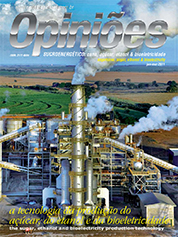Weber Francisco Capozzi
Director of Intacta Rolamentos
Op-AA-27
Technology, innovation and productivity
The business world is extensively debating the productivity issue. In general, the main focus has been on the cost department, with direct impact on maintenance, inputs, fixed costs, etc. Under pressure from Asian countries, developed open economy countries are looking at creative and unusual solutions in the endless quest for low costs, and hence, for competitiveness.
That is why some high level institutions – universities and large corporate conglomerates – are increasingly getting involved, thereby revealing the urgent need to develop new initiatives related to modern economies and productivity. This matter has been treated with much attention and is of high strategic value, given that it defines the success or the lack thereof of Western organizations vis-à-vis the challenges faced in regard to unfair competition (exchange rate, subsidized labor, government incentives, lack of labor-related legislation, patent protection, etc).
Among the issues that have been calling a lot of the attention of these organisms, have been the quality of communication and unquestionably innovative products and services. In order to be entirely successful in terms of communication quality, so as to transform it into productivity, some care and pre-requisites are required: resilience of interlocutors, maturity, discernment, flexibility and resourcefulness.
In the field of technological innovation, indicators are even more intangible. Until recently, the measure of a product’s or service’s innovation was its commercial success, i.e., the innovation measure came after investments were made. Therefore, it has not been possible to guarantee that investments in human resources, the flow of capital, and time spent on several projects, are successful.
Nowadays, one can already predict if such allocations of resources will be successful or not, thereby attributing value to new ideas that arise all the time. An outstanding master degree thesis by an electrical engineer of the University of São Paulo’s Polytechnical Institute, Ruy Santo, and his orientator, Marcelo Massarani – whose student I was –, shows how to precisely measure, through the “language” of engineering, innovative products and services, which were previously not measurable.
When resorting to these special instruments, one can see that the new debates on productivity are not confined only to the departments of purchasing, maintenance or costs, but also to creativity and to the most important of human abilities: intelligence. In order to perfectly well understand the new means to measure productivity, one must understand the essential difference between price and value.
Value is measured in the direct relation between price and performance, i.e., what is equipment’s or service’s performance given the price. In looking at the sugar-based energy industry, one can clearly see an aspect related to perfecting or improving that is different from innovating. Perfecting is a phase of a same product or service, whereas innovating is a new moment and a new proposal for a product or service.
However, in carefully analyzing two examples, one can observe the clear difference between perfecting and innovating. The sugarcane crusher has not undergone major changes in more than 100 years, albeit it has been perfected. While the crusher’s bearings manufacturers improve them, Brazilian companies – in special mills - using an innovative technology, reuse them, with expressive economical advantages, maintaining the same original quality request.
Reutilization with technological safety allowed the sugar market to not replace about 3,000 large bearings in five years (with borings larger than 200 mm). In analyzing a large bearing’s life cycle, one can observe substantial energy savings (95%) when reutilizing a bearing, as compared with replacing it with a new one.
By the same token, one can observe savings of 90% of mass, and of 98% of water, 100% in CO2 emissions, 99% in waste, among others. Thus, in analyzing the mentioned numbers in terms of engineering functions in the recuperation and reutilization process of bearings, we will observe a clear and unequivocal sign of an innovative technology.
With savings of about R$ 30 million by not replacing old bearings with new ones, one may conclude that the achieved productivity in such an unorthodox manner has been the result of correctly applying innovative technology, based on concepts of sustainability, preservation of capital, and hence, of natural resources. Intelligent maintenance: an opportunity for profit.




